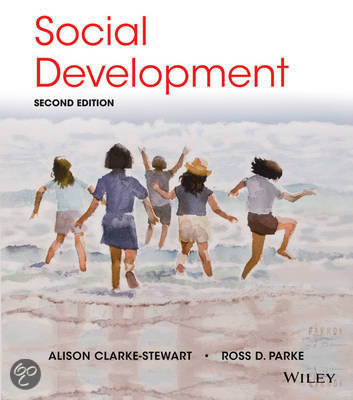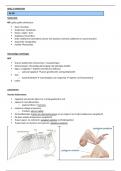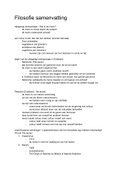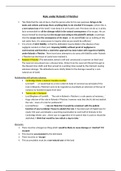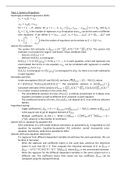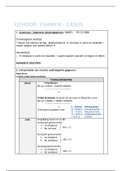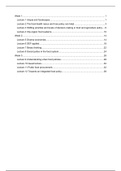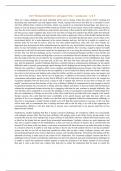Chapter 1
Social development
- Combination of nature and nurture guides the natural maturation
- Children influence their own development.
o E.g. they ask others for help. These interchanges are transactional.
- Don’t study children as a single unit, but rather study the social dyad. So
interactions with other people.
- Development seems discontinuous because there are distinct
developmental stages, but when we look closer, the developmental stages
occur continuous, not all of a sudden.
- Multifinality means that two people who start similarly can end up at very
different point
- Equifinality means that two people start at a different point, but reach the
same developmental end point
- Social development depends on the characteristics of the child, the adult
and the context
Psychodynamic perspectives
- Freud’s psychodynamic theory (B + E)
o Freud said that psychological growth is governed by unconscious
biologically based drives and instincts, like sex and aggression
o Personality consists of
Id: instinct, tries to maximize pleasure
Ego: rational, tries to gratify needs through appropriate,
socially constructive behavior
Superego: conscience, ability to apply moral values to their
own acts
o Development is discontinuous, contains 5 stages
Oral (0 – 1) Focus on eating and taking things into the mouth
Anal (1 – 3) Emphasis on toilet training: discipline and
authority
Phallic (3 – 6) Increase in sexual urges arouses curiosity,
gender differences
Boys experience Oedipus complex: attracted to mother,
jealous and fearful of father
Girls experience Electra complex: blame mother for
lack of penis, have sexual feelings for father
Latency (6 – 12 ) Sexual urges repressed, emphasis on
education
Genital (12 – 20)Sexual desires, expressing these urges
- Erikson’s psychosocial theory (E)
o Erikson said that development is discontinuous, contains 10 stages
Infancy (0 – 1) Task: Develop basic trust in oneself
and others
Risk: Mistrust of others and lack of self-
confidence
Early childhood (1 – 3) Task: Learn self-control and establish
autonomy
Risk: Shame and doubt about one’s own
capabilities
1
, Play age (3 – 6) Task: Develop initiative in mastering
environment
Risk: Feelings of guilt over aggressiveness
and daring
School age (6 – 12) Task: Develop industry
Risk: Feelings of inferiority over real or
imagined failure to master tasks
Adolescence (12 – 20) Task: Achieve a sense of identity
Risk: Role confusion over who and what
individual wants to be
Young adulthood (20 – 30) Task: Achieve intimacy with others
Risk: Shaky identity may lead to avoidance
of others and isolation
Adulthood (30 – 65) Task: Express oneself through
generativity
Risk: Inability to create children, ideas or
products may lead to stagnation
Mature age (65+) Task: Achieve a sense of integrity
Risk: Doubts and unfulfilled desires may
lead to despair
Traditional learning theory perspective
- Classical conditioning
o Pavlov did an experiment with dogs, food and a bell
o Watson did an experiment with Little Albert, using animals and a
loud noise
- Operant conditioning
o Skinner used a reward or punishment
- Drive-reduction theory
o Hull said classical and operant conditioning only works if it
accompanied by a drive reduction, like primary drives as hunger and
thirst
o These learning theories can be used to develop emotions or to
reduce them, e.g. fear. This is called desensitization
Cognitive learning perspective
- Bandura developed the cognitive social-learning theory. He used a Bobo
doll and realized that children copied aggressive behavior. This process is
influenced by
o Attention: do they pay attention
o Retention: can they remember it, can they use rehearsal
o Reproduction: can they reproduce it or is it too difficult
o Motivation: are they motivated to do so
- Reciprocal determination means that everything influence everything, like
a ping-pong game
- Children develop a sense of self-efficacy, whereby they contribute to their
own social development by their perception of how competent they are
o Collective efficacy is a group’s shared belief in its ability as a unit to
achieve some goal
Information-processing perspective
2
, - Social information processing theory says children proceed through a
series of cognitive-processing steps to understand specific behavior, e.g.
why is he doing this and how should I respond?
Cognitive developmental perspective
- Piaget’s cognitive developmental theory
o Piaget used two processes in children’s development (B x E)
Assimilation in which children use their existing knowledge as
a framework for new experiences
Accommodation in which children realize they have to modify
their existing knowledge in order to understand new
experiences
o His stages of cognitive development
Sensorimotor (0 – 2) Differentiates self from objects and
other people, seeks interesting sights, develops object
permanence and basic understanding of causality, begins to
imitate and engage in imaginative play
Preoperational (2 – 7) Begins to use symbols and
language; problem solving is intuitive and thinking is
egocentric, irreversible and centered
Concrete operational (7 – 12) Can reason logically about
present objects, grasps concept of conservation, can take the
perspective of another person, can organize objects into
classes and series
Formal operational (>12)Thinking is flexible and complex; can
think about abstract ideas and hypotheses
o Children are egocentric: how I feel and see things is how other
people are feeling and seeing. They have difficulty to take the
viewpoint of others
- Vygotsky’s sociocultural theory
o Vygotsky emphasized the importance of the child’s social world (E)
o Three principles of cultural influence
Cultures vary in the settings and practices they provide
These settings and practices facilitate children’s development
Children learn about their culture from experienced members
of the culture
o The zone of proximal development is the difference between
children’s level of performance working alone and their level of
performance working with an experienced partner
Systems-theory perspective
- Bronfenbrenner’s ecological theory focuses on the multiple systems in
which children are embedded and how these systems are linked. It
stresses the importance of the relations between the child and these
systems and the relations among the systems themselves (E)
o Microsystem: system in which a child interacts directly with people
and institutions
o Mesosystem: consists of the interrelations among the components of
the microsystem, e.g. relation between parents and teachers
o Exosystem: composed of settings that impinge on a child’s
development but with which the child has largely indirect contact,
e.g. worktime parents
3
, o Macrosystem: ideological and institutional patterns of a particular
culture
o Chronosystem: within time, changes occur within the child or in one
of the systems
Biological perspective
- Ethological theory by Lorenz and Tinbergen is based on the belief that to
understand behavior, we must view it as occurring in a particular setting
and as having adaptive or survival value and must study it in relation to
the organism’s biology and the ecosystem in which the organism functions
(B + E)
o We have a critical period, which is a specific time in an organism’s
development during which external factors have a unique and
irreversible impact
o Lorenz did an experiment with imprinting and geese
- Evolutionary developmental theory focuses on behaviors that ensured
survival of the species in the past. We are programmed to pass our genes
to the next generation. (B + E)
- Life history theory suggest that the schedule of key events over the life
course is influenced by natural selection to produce the largest possible
number of surviving offspring and thus maximize the successful passing on
of the organism’s genes
o Children living in at-risk environments reach sexual maturity more
quickly and begin reproduction earlier. This means maximizing their
success in transmitting their genes
- Human behavior genetics studies how nature and nurture influence each
other and especially reinforce each other. (B x E)
Life span perspective
- Extends the frame of development beyond childhood through adulthood.
(B + E)
- Change can be traced to
o Normative events: are expected and happen for everyone at the
same time +/-
E.g. menstruation, going to school, etc.
o Nonnormative event: are unexpected
E.g. divorce, job loss, teen pregnancy
o Historical events. People born in the same age period make up age
cohorts and share the same historical experience, e.g. the use of
internet
Chapter 3
Genetics and social development
- Chromosomes consist of genes
- Human behavior genetics focused attention on estimating genetic
contributions to the array of individual differences in social behavior
o At first, they did not directly study DNA, but the heritability factors,
or percentage estimates of the contribution that heredity makes to a
particular ability or type of behavior
o They try to assess the interactions between genes and
environments and to estimate the extent to which each contributes
to a trait or behavior
- A genotype is the particular set of genes that a person inherits
4

